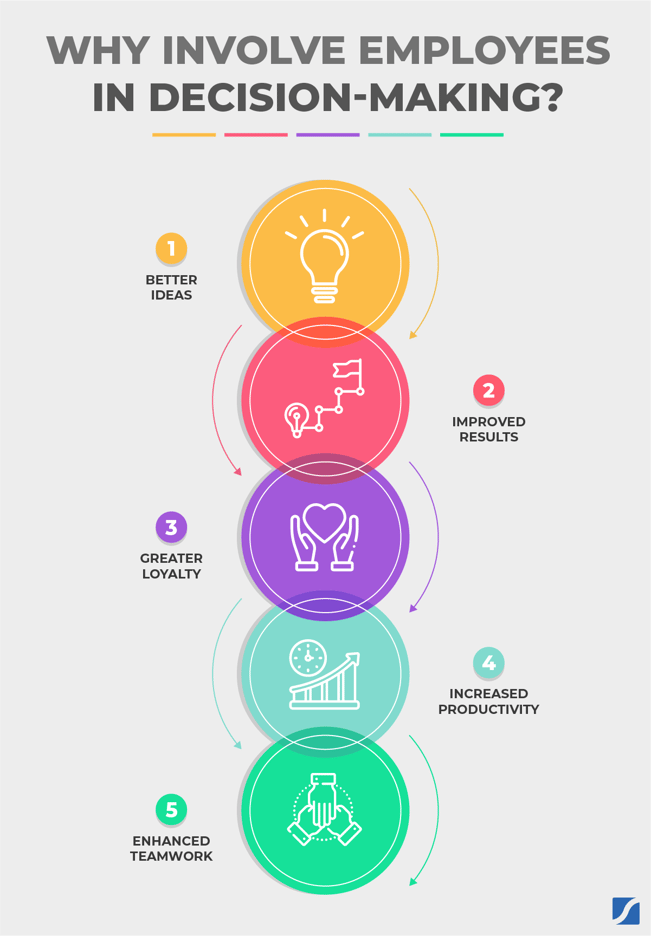How Employee Involvement In Decision-Making Helps Your Business Grow

When Jack Stack and 12 fellow managers bought their factory from their employer to keep it in business, they quickly learned that employee involvement produces both tangible and intangible rewards.
The new owners encouraged employee involvement—and, within the first four years, the factory’s sales grew by more than 30%, they went from a loss of more than $60,000 to pre-tax earnings of $2.7 million. And they avoided any layoffs.
But the benefits of actively involving employees also went deeper:
“We’ve created economic value along the way,” Jack says. “But more importantly, we teach people how to make a difference. And that’s what we so desperately need in the world.”
What, exactly, is employee involvement? Why should you encourage employee involvement in your own business? And how do you put it in action to benefit your company and employees?
Let’s start with a definition.
What Is Employee Involvement?
Employee involvement refers to an employee’s active pursuit of an organization’s objectives. An involved employee helps drive the business forward by playing a significant role in the actions that add value.
An involved workforce feels as though they have an influence on more than just their own work. Ownership of corporate decisions and actions extends beyond executives and board members. In fact, In the Great Game of Business course, Steve Baker describes the commitment to employee involvement as “building a business of business people who think, act, and feel like owners.”
And, when you consider this quote from Jag Randhawa, author of The Bright Idea Box: A Proven System to Drive Employee Engagement and Innovation, it’s not hard to understand why that emphasis on employee involvement can lead to impressive gains.
“All employees,” Randhawa says, “have an innate desire to contribute to something bigger than themselves.”
Employee Involvement Vs. Employee Engagement
“Employee involvement” and “employee engagement” are separate concepts, but the correlation between them may explain why people often use the terms interchangeably. After all, involved employees typically are engaged employees.
Employee engagement describes the connection that employees feel to their company’s mission, vision, and objectives. Employee involvement strengthens this connection; it encourages participation in the decision-making and actions that drive the mission, vision, and objectives.
And if involvement feeds engagement, it’s something to which every company should aspire. A disengaged workforce has a host of negative repercussions, not the least of which is its impact on earnings.
An Engagement Institute study of 1,500 companies, for example, shows the cost of disengaged employees can reach up to $550 billion each year.
What Are The Benefits Of Involving Employees In Decision-Making?
From generating diverse ideas to facilitating financial breakthroughs, involving employees in decision-making can pay a variety of dividends. Following are 5 key benefits of employee involvement.
Better Ideas
Inviting many voices to the table often yields innovative ideas that corporate executives hadn’t considered. Employees have a deeper understanding of the nuts and bolts that comprise day-to-day operations, which makes them an invaluable resource for insight about possible outcomes and which approaches are likely to succeed.
Improved Results
When employees play an active role in their company’s decision-making, they take ownership of the outcomes. And that makes them want to go the extra mile to ensure those decisions work—and to correct issues that might get in the way of success. Those outcomes can translate to big financial gains, as Stack’s example and methodology show.
Greater Loyalty
Providing employees with details about your corporate operations—and opportunities to offer ideas for improving them—shows a confidence in them that eliminates drama and encourages loyalty. Happy employees are more likely to stay in their positions and tout your business to the A-players who will help drive future success.
Increased Productivity
Freeing up the leadership team’s time by tasking employees with decision-making responsibilities frees up leaders to tackle other issues, and it encourages greater productivity at every level of the organization. Additionally, the same sense of confidence that inspires loyalty often encourages employees to dedicate more focused attention to the task at hand.
Enhanced Teamwork
An emphasis on including employees in decision-making means more collaboration among leaders and staff at all levels. This open sharing of knowledge and ideas promotes stronger working relationships and better teamwork throughout the company.
Download The Great Game of Business Course Outline
8 Ways To Encourage Employee Involvement In Decision-Making
What are the steps to take to encourage the high level of employee involvement that provides so many benefits? Try these 8 approaches for enlisting employees to generate ideas and make decisions.
1. Suggestion Box
Whether it’s a physical box where employees submit hard-copy forms with ideas or a digital version for electronic submission, a suggestion box can encourage ideas from everyone. It’s critical, however, that your organization’s leaders check and respond to the ideas regularly—and act on those that show promise.
2. Staff Surveys
Another option for submitting ideas by paper or electronically is an employee survey. One approach is to include a survey with each performance review form. When employees receive suggestions, they can also offer their own feedback, helping inform decisions about their efforts and those of the company.
3. Employee Goal-Setting
Permitting employees to play a role in setting their own goals for performance and development gives them a greater role in decision-making. It also provides a greater sense of pride and ownership as well as more incentive to meet those goals.
4. Leadership Committees
Leadership committees can include employees who are in a variety of roles, management and otherwise. These groups, which might focus on general business operations or specific aspects of the company, meet regularly to generate ideas and make decisions.
5. Brainstorming Days
Scheduling days devoted solely to generating ideas encourages innovative suggestions for achieving business goals. The day could involve asking small groups of employees to pitch creative solutions for specific issues.
6. Open-Door Policies
Giving employees the freedom to approach executives with comments and ideas encourages a free flow of information. This open-door policy also shows employees that your company’s leaders value their input.
7. Board Meeting Participation
Offering employees opportunities to participate in board activities can promote collaboration and invite a broad range of ideas. To keep size manageable, selecting representatives from different departments to attend.
8. Common Financial Language
Open book management (OBM), the approach at the heart of The Great Game of Business, helps to demystify the process of making money and generating cash and profit. When employees and executives speak the same language regarding finances, they’re on the same page in making decisions that drive company growth..png?width=669&height=225&name=EN_GGoB_MKT_Download%20Outline_24-03-12%20(1).png)
What Resources Can Help You Keep Employees Engaged In Your Mission?
Now that you’ve learned the what’s, why’s, and how’s of employee involvement, it’s time to discover more about how it can help you scale your business. Following are some resources to get you started.
Books On Employee Involvement
These books explore how employers can get employees involved in decision-making:
The Bright Idea Box: A Proven System To Drive Employee Engagement And Innovation by Jag Randhawa
CRAVE: You Can Enhance Employee Motivation In 10 Minutes By Friday by Greg Ledderman
Get In The Game: How To Create Rapid Financial Results And Lasting Cultural Change by Rich Armstrong and Steve Baker
The Great Game Of Business: The Only Sensible Way To Run A Company by Jack Stack
Start With Why: How Great Leaders Inspire Everyone To Take Action by Simon Sinek
Worth Doing Wrong: The Quest To Build A Culture That Rocks by Arnie Malham



